A self-study, self-paced course where you can learn how to paint in watercolor by watching video lessons and doing assignments
$297 USD
ENROLL NOWA self-study, self-paced course where you can learn how to paint in watercolor by watching video lessons and doing assignments
$297 USD
ENROLL NOWOne-to-one, unlimited and custom-tailored to your skills and needs Personal Tutoring by the Watercolor Academy teachers
$997 USD
ENROLL NOWBy Anna Ivanova
The subject for today's lesson is backstage at a ballet. I'll show you how to paint in watercolor the multi-figure composition that features the ballet dancers, how to paint their clothes and accessories, and how to unite the whole composition with a dark background. Here is the finished piece we will have by the end of this video lesson.
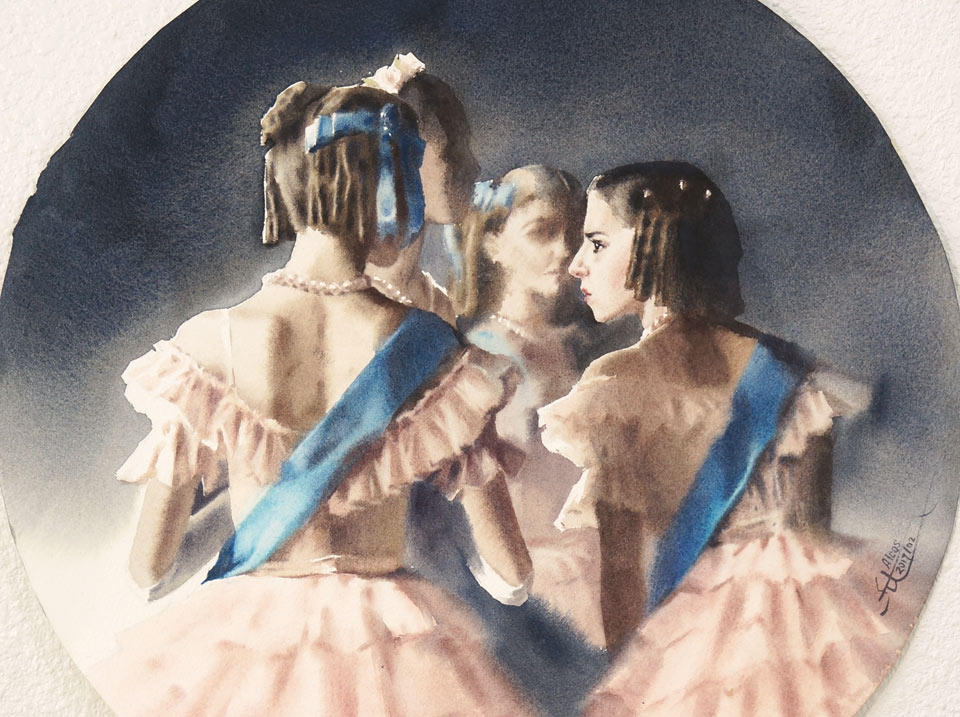
The models for this artwork are ballet dancers who are waiting their turn to get on the stage and perform their part in The Fairy Doll ballet. This ballet originally was created in 1903 in St. Petersburg, Russia.
I cut out a circle of watercolor paper, which will give an interesting layout for this composition. After moistening the back side of this circle, I turn it over and apply clean water on its front side. I saturate the paper with water using a soft, flat brush, making sure there are no dry gaps left. It will take about ten to fifteen minutes for the paper to absorb the water and to dry from a saturated to a moist level. I will paint this piece alla prima, using the dry-brush-on-moist watercolor painting technique.
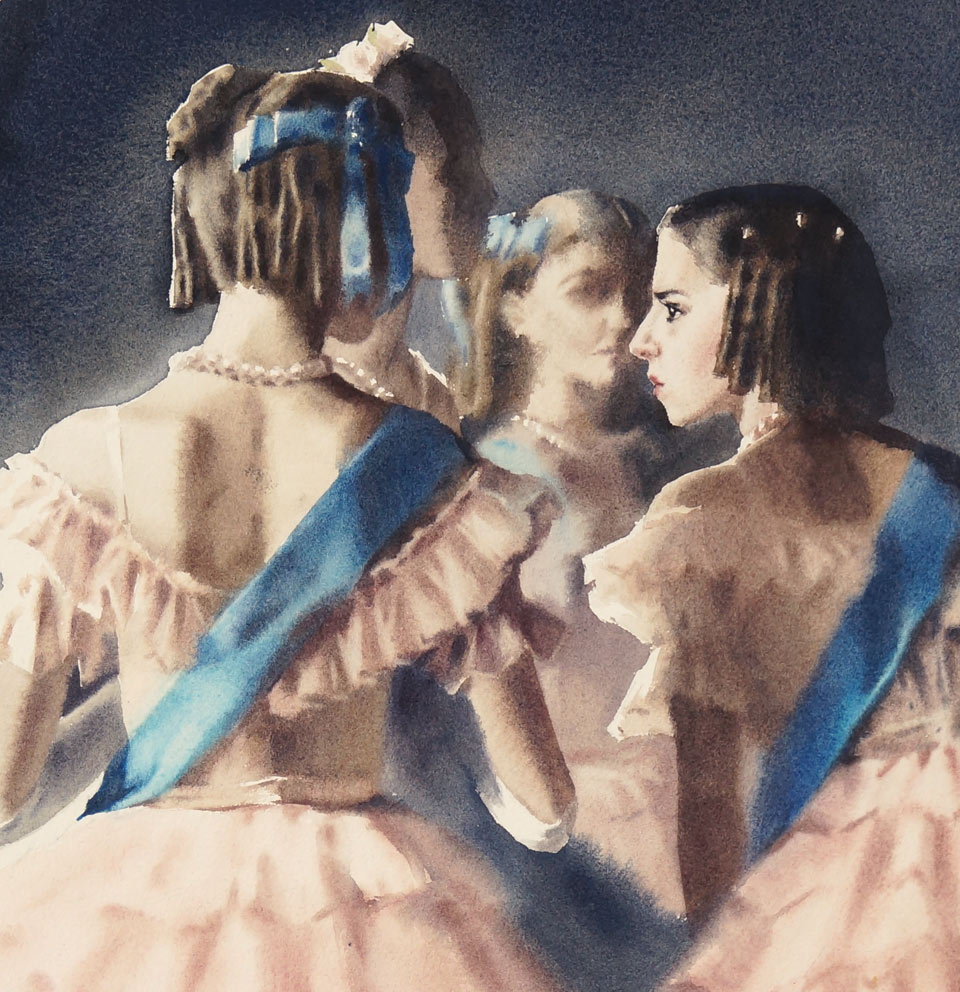
I begin painting the lightest tones in this piece. For the skin color of the ballet dancer, I mixed raw sienna, phthalo blue, burnt umber, and orange. Different proportions of those pigments can produce a wide range of colors, from cool to warm ones. For the darker tones of flesh, I'm using orange, raw sienna, and burnt umber, and add a bit of phthalo blue to make this mix cooler and darker. The paper is moist and so is the brush. It contains very little water for the dry brush technique. In watercolor, it is always better to paint from light to dark tones. For the light color of their hair, I'm using ultramarine, phthalo blue, and burnt umber. By adding more burnt umber into this mix, I can make it warmer and, with the addition of more ultramarine, this mix will become darker and cooler. I started this piece with the figures, and when all figures are done, I will add a background. I use this sequence because the background will be darker than the figures and this follows one of the main rules of watercolor painting, which says that the process should go from light to dark areas. You may see that every brush stroke I do stays in place. This is because the paper surface is moist. There's no liquid water on it, and the brush is almost dry, so it holds more paint than water. This makes it possible to make brush strokes with sharp edges and allows me to paint the color in its full strength, applying a limited number of paint layers. The pigment is only loaded on the tip of the brush. The brush barely remains damp. To remove excess water from the brush, I blot it using a paper napkin from time to time. This dry-brush-on-moist watercolor painting technique is a great way to paint small details. Such details will stay well-defined and it is easy to keep control over the paint flow.
For the very light, pinkish color of the dress, I'm using orange and raw sienna. I start painting the dress from its highlights. For the darker colors of the dress, I'm using orange, burnt umber, and a bit of phthalo blue to make it darker and cooler. Because there are complementary pigments in this mix, orange and blue, this mix can potentially be very gray. That is why a very small amount of blue is used here. For the blue ribbon, I'm mixing phthalo blue and ultramarine.
Diaghilev's ballet, The Fairy Doll, has over a 100-year history. The story this ballet tells is quite simple: Two families visit a toyshop to buy dolls for their children. The shopkeeper shows all the dolls he has, including mechanical dancing dolls from different countries: Japan, China, Austria, Spain, and Hungary. The nobleman buys the fairy doll and the farmer, two others. When the working day is over, the shopkeeper closes the shop, accidentally locking in the shopkeeper, a boy, and when the clock strikes midnight, this boy witnesses a mesmerizing ball where all dolls become alive and dance the ballet. The dolls' dresses were designed by Léon Bakst, a Russian painter and clothing designer, who worked closely with Sergei Diaghilev in the ballet production. Here is a drawing by Léon Bakst of The Fairy Doll. You can see that the modern costume for the ballet closely follows its original design.
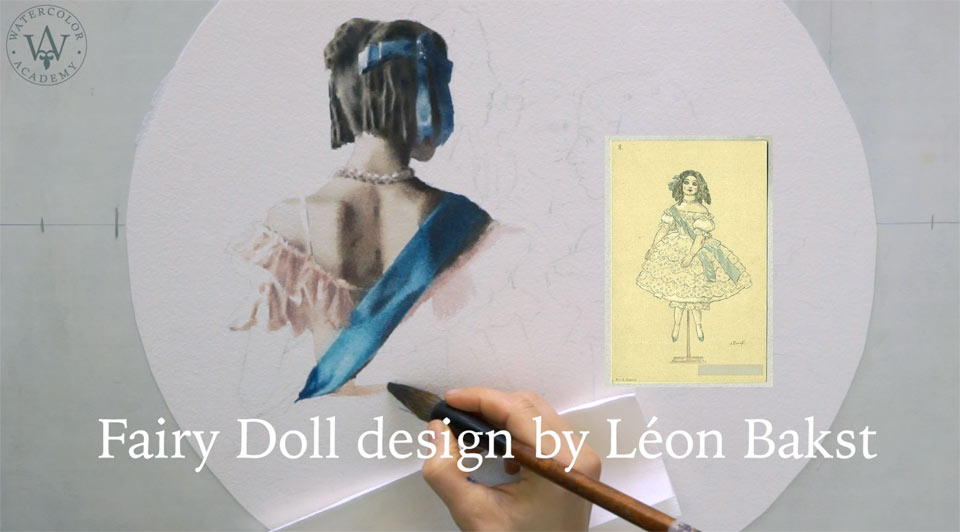
You may notice that I'm painting from the top left corner and do the object bit by bit till it is fully complete. This prevents me from smudging wet paint with my hand. The dry-brush-on-moist watercolor paint technique has its advantages and downsides as well. The main advantage is that it makes it possible to keep the borders of brushstrokes well-defined, although painted on the moist paper surface. Such a surface allows making wet-into-wet brush strokes with soft and diffused borders. It is suitable for alla prima and painting the whole artwork in one session makes this technique very fast.
The biggest advantage of the dry-brush-on-moist technique is the ability to keep full control over the paint flow. However, there are limitations. For example, an artwork has to be finished while the paper is moist, otherwise it will become dry-brush-on-dry or wet-on-dry painting technique. This requires a high speed of painting with very few breaks to manage the whole picture in one session. Another limitation is that only a few layers can be done with dry-brush-on-wet. And wet-on-dry glazing is not possible while the paper is moist. Here's how I paint the dress: First, I apply an underpainting in very light tint and this color will remain for highlights. With the underpainting in place, I can add more paint on top to make some areas darker and more saturated. I can do it with a round or a flat brush but I have to load the brush with very little water. A dry brush and moist paper prevent brush strokes from spreading out. This way, I have full control over how the paint is applied on the paper and, to achieve more defined details, I'm using a smaller brush.
With the foreground figure complete, I will now do the figure in the middle ground. For the face color, I'm using orange, raw sienna, and a bit of phthalo blue. Complementary colors are mixed into very light pinkish-gray. This is the under-painting which is the base for darker tones to be painted on top. Although this composition looks quite complicated, there is only one dancer who will have a detailed face. This will make the job easier because you only paint dressed figures and the background instead of multiple portraits.
How to paint a portrait using the dry-brush-on-wet watercolor painting technique will be fully presented in the next video lessons. You may see that even tiny details are staying as I paint them, which is the great advantage of the dry brush technique. One of the main challenges in any watercolor painting is to get the tonal values right. The color of the skin can vary depending on the direct and reflected light. If you do it a bit cooler or warmer, this would only mean that cool or warm light lit the figure. However, if an artist makes mistakes in tonal values, the picture would render incorrect. So, the main challenge I have at this moment is to make the correct guess of how dark tonal values should be. It is not easy because the dark background is not painted yet. The ballet dancers figures look quite dark on white paper. But, trust me, when the dark background will be added, these figures will appear very light. Painting the hair follows the same sequence, from light to dark tones. First, light underpainting is applied and its color will be the color for the hair's highlights, and dark brush strokes are added next to it. The same way I'm painting the dress. You may notice that I am using the same round brush for smaller and bigger details. This is my favorite brush because it is very versatile. I can add very small details with its well-pointed tip or I can squeeze this tip between my fingers to make it flat and use this brush as if it is a small flat brush which is capable of producing much wider brush strokes.
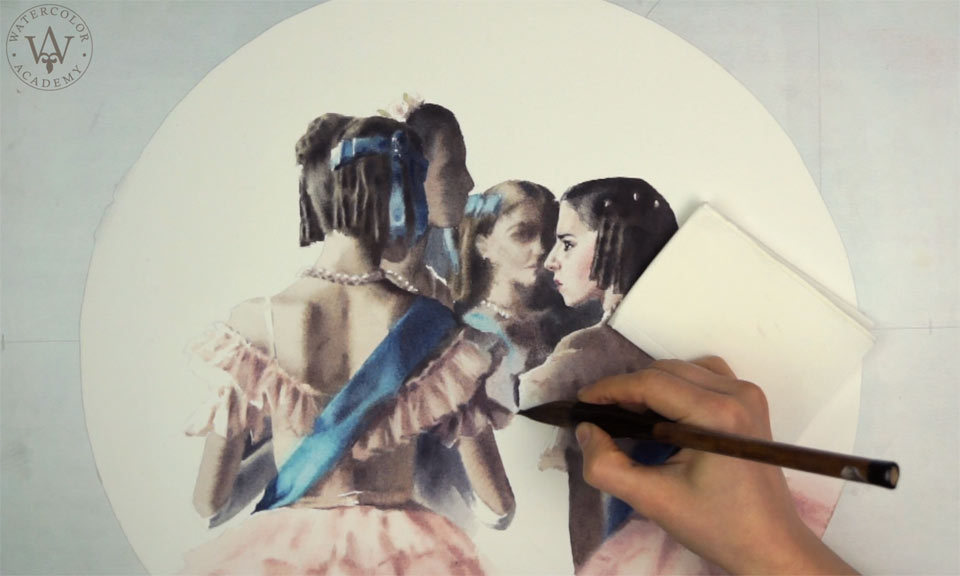
Don't ask me what this brush is and where to buy it. It is a Chinese brush which tends to have very low quality and hairs of questionable origin which may come from any animal you can think of. But after testing dozens and dozens of brushes, somehow I got used to this one and now could not go without it. What is a good brush for you will only become clear after many, many hours of practice.
I have to say a few words about how to care for your paint brushes. After the painting session is over, wash all brushes that you've been using and place them to dry horizontally. If you dry brushes vertically, hairs up, water and remaining pigments will sink down. This might damage the brush, should you dry brushes all the time that way. The biggest damage you can do to the brush is by leaving it to soak in the water jar. Over time, hairs will bend and lose their shape, wooden handles will expand and possibly crack, and the lifespan of the brush will be reduced greatly. A good quality watercolor brush will stay in great shape for many years should you look after it. With time, you will find your favorite brushes. Sometimes an expensive brush will be much more economical and give better value for money because it will last much longer than the whole bunch of disposable, cheap brushes. Once again, you can see that I apply the underpainting layer for the dress, and now I'm adding smaller details, painting in darker tones and brighter saturation on top of this underpainting. Because the second layer brings more water to the paper surface, I have to use even less water on the brush. Now it's time to do the remaining figures. You may notice that I placed a paper napkin under my hand. This is not ideal because it covers the girl's head but it is better than smudging still-wet paint with my hand. I'm painting the silhouette of the girl's face. It is in shadow and therefore is dark. Its dark gray color is a mix of complementary cool and warm pigments. This face will remain very laconic without many details. There is another girl in the background. Because it is a background figure, I won't be making too many accents on her face and would like to keep it less detailed than the face of the girl who is looking to the left. Using a very dark tone, I'm painting the piece of background between two girls. Four figures are almost complete. I will add some finishing touches to the last figure before continuing to the background.
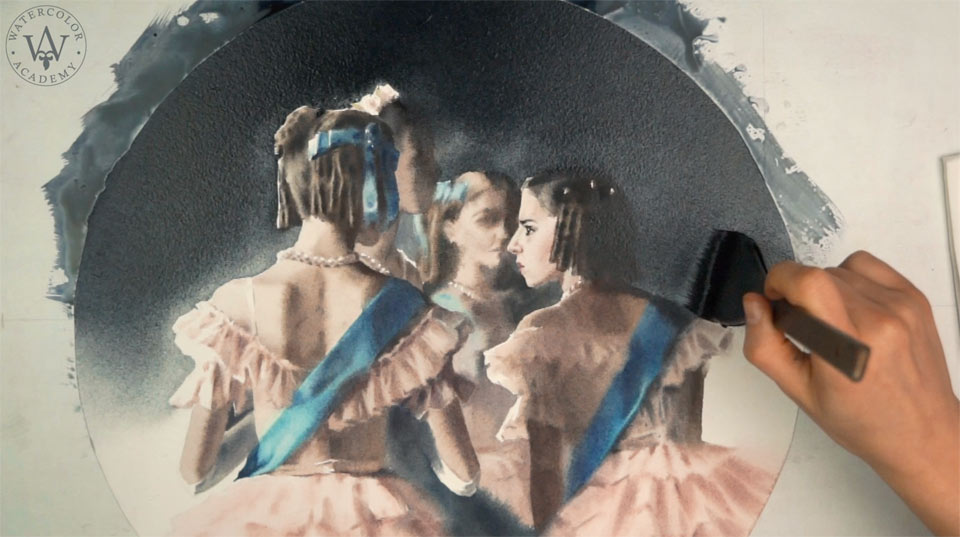
These four ballet dancers might look a bit strange on the white background. This will change when I paint the background in dark colors. For the background color, I'm mixing ultramarine and sepia pigments. Such a mix can be very dark, almost black. I apply it with a flat, wide brush which has soft hairs and holds a lot of paint. There is a bit more water on the brush and it is no longer the dry-brush-on-wet painting technique but instead is wet-into-wet.
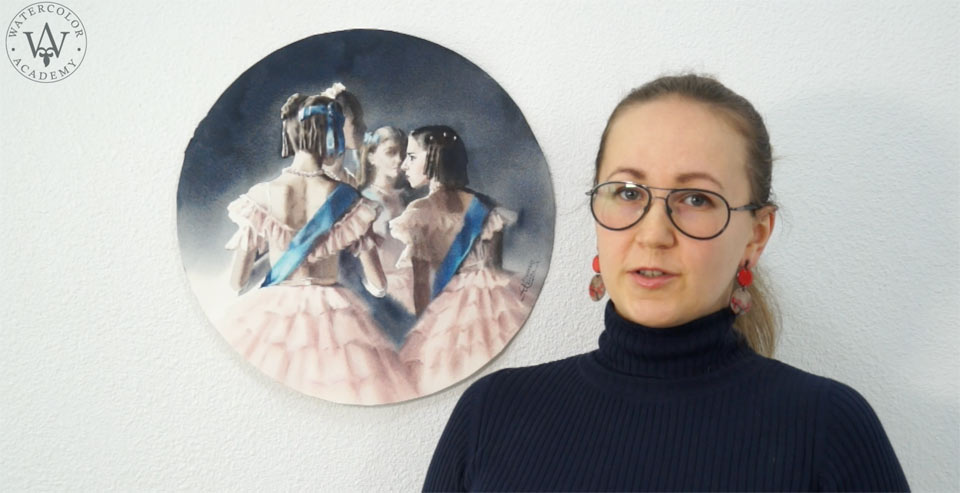
You may see that I did not paint with the big brush to the very edge of the figures but left about half a centimeter (1/4 inch) gap between brush strokes and the figure outlines. Now, I fill this gap, applying paint with a smaller brush. And this time, I load enough pigment but much less water on the brush to work in the dry-brush-on-wet technique. This way, I can keep control over the brushstroke edge and prevent dark paint blooming onto the light figures. Where the dark background borders the dark hair of the girl, I paint confidently with a big flat brush and do not worry about overlapping...
A self-study, self-paced course where you can learn how to paint in watercolor by watching video lessons and doing assignments
One-time payment - Lifetime membership
$297 USD
One-to-one, unlimited and custom-tailored to your skills and needs Personal Tutoring by the Watercolor Academy teachers
One-time payment - Lifetime membership
$997 USD